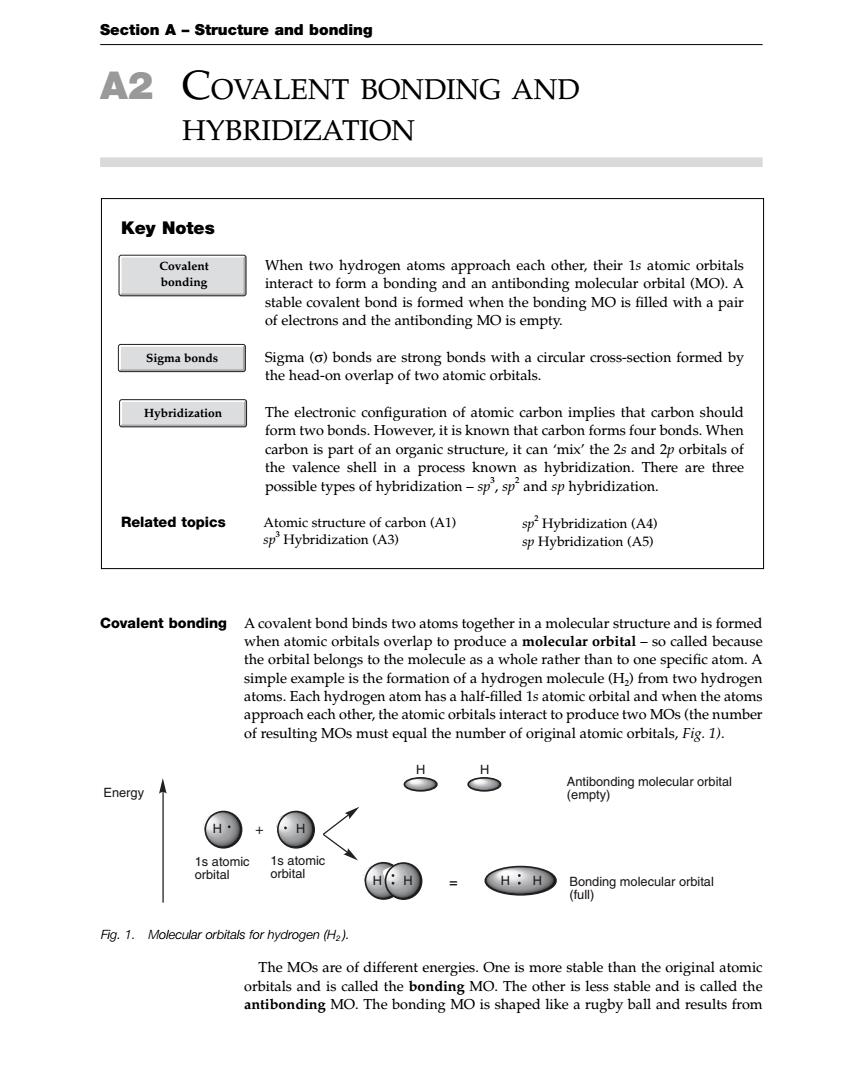正在加载图片...

Section A-Structure and bonding A2 COVALENT BONDING AND HYBRIDIZATION Key Notes Covalent When two hydrogen atoms approach each other,their Is atomic orbitals bonding interact to form a bonding and an antibonding molecular orbital(MO).A stable covalent bond is formed when the bonding MO is filled with a pair of electrons and the antibonding MO is empty. Sigma bonds Sigma (o)bonds are strong bonds with a circular cross-section formed by the head-on overlap of two atomic orbitals. Hybridization The electronic configuration of atomic carbon implies that carbon should form two bonds.However,it is known that carbon forms four bonds.When mix'the 2s and 2p orbitals of s hvbridiza ion.Ther Posibteypesofnbridaiom-ppadphybrid2atioh are three Related topics A) Covalent bonding Acovalent bond binds two atoms together in a molecula nic orbitals caularorbi one spe A atoms. om has a hal n two hydrogen the atoms the number of resulting MOs must equal the number of original atomic orbitals,Fig.1). Energy &gdngmoecularobtadl ⊙+ meamc = H:H ondingmolecular orbital Fig.1.Molecular orbitals for hydrogen (Ha). The MOsare of different enere One is more stable than the orinal atomic MO he c er is le an antibonding MO.The bondingM is shaped likea ruby ball and results from Section A – Structure and bonding A2 COVALENT BONDING AND HYBRIDIZATION Covalent bonding A covalent bond binds two atoms together in a molecular structure and is formed when atomic orbitals overlap to produce a molecular orbital – so called because the orbital belongs to the molecule as a whole rather than to one specific atom. A simple example is the formation of a hydrogen molecule (H2) from two hydrogen atoms. Each hydrogen atom has a half-filled 1s atomic orbital and when the atoms approach each other, the atomic orbitals interact to produce two MOs (the number of resulting MOs must equal the number of original atomic orbitals, Fig. 1). The MOs are of different energies. One is more stable than the original atomic orbitals and is called the bonding MO. The other is less stable and is called the antibonding MO. The bonding MO is shaped like a rugby ball and results from Key Notes When two hydrogen atoms approach each other, their 1s atomic orbitals interact to form a bonding and an antibonding molecular orbital (MO). A stable covalent bond is formed when the bonding MO is filled with a pair of electrons and the antibonding MO is empty. Sigma (σ) bonds are strong bonds with a circular cross-section formed by the head-on overlap of two atomic orbitals. The electronic configuration of atomic carbon implies that carbon should form two bonds. However, it is known that carbon forms four bonds. When carbon is part of an organic structure, it can ‘mix’ the 2s and 2p orbitals of the valence shell in a process known as hybridization. There are three possible types of hybridization – sp3 , sp2 and sp hybridization. Related topics Atomic structure of carbon (A1) sp3 Hybridization (A3) sp2 Hybridization (A4) sp Hybridization (A5) Covalent bonding Sigma bonds Hybridization + 1s atomic orbital 1s atomic orbital = Bonding molecular orbital (full) Antibonding molecular orbital Energy (empty) H H H H HH HH Fig. 1. Molecular orbitals for hydrogen (H2 )